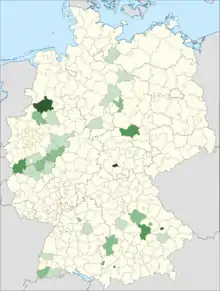Albanians in Germany
The Albanians in Germany (German: Albaner in Deutschland; Albanian: Shqiptarët në Gjermani) refers to the Albanian migrants in Germany and their descendants. They mostly trace their origins to Albania, Kosovo[lower-alpha 1] and to a lesser extent to North Macedonia and other Albanian-speaking territories in the Balkan Peninsula. Their exact number is difficult to determine as some ethnic Albanians hold German, North Macedonian, Serbian or another Former Yugoslavian citizenship.
| Total population | |||||||||||
|---|---|---|---|---|---|---|---|---|---|---|---|
| Regions with significant populations | |||||||||||
| |||||||||||
| Languages | |||||||||||
| Religion | |||||||||||
| Related ethnic groups | |||||||||||
| Albanians in Austria and Switzerland | |||||||||||
a The number includes nationals from Albania and Kosovo. | |||||||||||
| Part of a series on |
| Albanians |
|---|
 |
| By country |
|
Native Albania · Kosovo Croatia · Greece · Italy · Montenegro · North Macedonia · Serbia Diaspora Australia · Bulgaria · Denmark · Egypt · Finland · Germany · Norway · Romania · South America · Spain · Sweden · Switzerland · Turkey · Ukraine · United Kingdom · United States |
| Culture |
| Architecture · Art · Cuisine · Dance · Dress · Literature · Music · Mythology · Politics · Religion · Symbols · Traditions · Fis |
| Religion |
| Christianity (Catholicism · Orthodoxy · Protestantism) · Islam (Sunnism · Bektashism) · Judaism |
| Languages and dialects |
|
Albanian Gheg (Arbanasi · Upper Reka · Istrian) · Tosk (Arbëresh · Arvanitika · Calabria Arbëresh · Cham · Lab) |
| History of Albania |
As of 2018, there are approximately 270,000 Albanians distributed in the territory of Germany composed of 218,150 Kosovar nationals and 55,495 Albanian nationals.[1] They are predominantly concentrated in the states of Baden-Württemberg, Bayern, Hessen, Nordrhein-Westfalen and Niedersachsen.[3] Berlin, Hamburg, München and Stuttgart represent the metropolitan areas with the most significant Albanian population in the country.
Germany maintains close ties with Albania and Kosovo which are characterised by a spirit of economic and political partnership.[4][5] Relations with Albania have become more significantly after the collapse of communism in 1991 as the country paved the way of a democratisation process. Germany was also one of the first countries to officially recognise and establish diplomatic relations with Kosovo after it declared its independence in 2008.[6]
History
The first mention of Albanians being present in Germany was during the wars of Austrian Succession fighting as stratioti mercenaries for Empress Maria Teresa.[7]
In the modern era, Albanian migrants came to Germany as gastarbeiter in the middle of the 20th century.[8] They came to the country as Yugoslavian migrant workers from the recruitment state of Yugoslavia. They were usually regarded as Yugoslavs and not as Albanians because they came from Kosovo and North Macedonia which at that time were part of Yugoslavia. Nevertheless, more and more Albanians arrived in the country since the beginning of the 1980s.
In 1990, more than 3,000 Albanian nationals fled the communist regime of Albania in the German Embassy Tirana and were later allowed to travel on via Italy to Germany as embassy refugees.
During the Kosovo war in 1999, many Kosovo Albanians sought asylum in the Federal Republic of Germany. By the end of 1999, the number of Kosovo Albanians in Germany was about 480,000, about 100,000 had returned voluntarily after the war in their homeland or been forcibly removed.
In the Kosovo war in 1999, relatively many Kosovo Albanians came to Germany fled from Serbian aggression. In Berlin, about 23,000 Albanians lived in 1999. In 2015, there was another wave of Albanian immigration when tens of thousands of people from the Western Balkans traveled to Germany and applied for asylum. In the first six months of this year, 31,400 people from Kosovo and 22,209 people from Albania sought asylum in Germany, although there was little chance of success. By the end of the year, the numbers increased to 54,762 people from Albania and 37,095 people from Kosovo. In addition to the high unemployment and lack of perspective also targeted disinformation by tour operators and people smugglers is seen as the cause of mass immigration. The Federal Office for Migration and Refugees tried to prevent further Albanians from leaving for Germany by advertising and media campaigns. Many left Germany months later voluntarily, while others were deported and were banned from entering the Schengen area.
Demography
Based on results of the German mikrocensus of 2018, there were approximately 270,000 Albanians distributed in the territory of Germany composed of 218,150 people with Kosovan nationality and 55,495 people holding Albanian nationality.[1] The exact estimation of Albanians in the country could be higher but note that official data gives no indication of ethnic backgrounds.[9]
In Berlin in 1999, there were about 25,000 Albanians, the number dropped because of remigration and Germany's general population decline. It is quite hard to know the true number of Albanians in Germany, as they were defined as Yugoslavs or Macedonians when they came to Germany. Germany is the most popular destination for Kosovar Albanians seeking to emigrate to Western Europe.
Statistics

The states with the most significant concentration of Albanians are Baden-Württemberg, Bayern and Nordrhein-Westfalen mostly in western Germany. The most lesser number are to be found in Brandenburg, Mecklenburg-Vorpommern, Sachsen-Anhalt and Saarland. Berlin, Hamburg, München and Stuttgart represent the metropolitan areas with the most significant concentration of Albanians in Germany.[10][11]
| State Bundesland |
2018[3] |
2018[3] |
|---|---|---|
| 7,480 | 58,340 | |
| 7,520 | 47,850 | |
| 1,880 | 4,575 | |
| 840 | 650 | |
| 1,210 | 1,885 | |
| 1,505 | 2,435 | |
| 4,205 | 11,050 | |
| 305 | 185 | |
| 5,310 | 15,795 | |
| 17,185 | 55,355 | |
| 2,840 | 10,755 | |
| 435 | 2,090 | |
| 1,360 | 1,620 | |
| 790 | 1,180 | |
| 1,550 | 3,065 | |
| 1,080 | 1,330 | |
| 55,495 | 218,150 | |
The distribution of Albanians in Germany according to the Statistical offices of the German states (2018):
| State | Note | ||
|---|---|---|---|
| 2,256 | 4,709 | ||
| 1,481 | 2,442 | ||
| 4,205 | 11,050 | ||
| 305 | 185 | ||
Notable people
Selected people:
See also
Notes
- Kosovo is the subject of a territorial dispute between the Republic of Kosovo and the Republic of Serbia. The Republic of Kosovo unilaterally declared independence on 17 February 2008. Serbia continues to claim it as part of its own sovereign territory. The two governments began to normalise relations in 2013, as part of the 2013 Brussels Agreement. Kosovo is currently recognized as an independent state by 98 out of the 193 United Nations member states. In total, 113 UN member states recognized Kosovo at some point, of which 15 later withdrew their recognition.
References
- "Bevölkerung und Erwerbstätigkeit - Ausländische Bevölkerung Ergebnisse des Ausländerzentralregisters 2018" (PDF). destatis.de (in German). Statistisches Bundesamt (DESTATIS). p. 66. Retrieved 15 April 2019.
- Hans-Peter Bartels: Deutscher Bundestag - 16. Wahlperiode - 166. Sitzung. Berlin, Donnerstag, den 5. Juni 2008 Archived January 3, 2013, at the Wayback Machine
- "Bevölkerung und Erwerbstätigkeit - Ausländische Bevölkerung Ergebnisse des Ausländerzentralregisters 2018" (PDF). destatis.de (in German). Statistisches Bundesamt (DESTATIS). pp. 97–99. Retrieved 15 April 2019.
- "Germany and Albania: Bilateral Relations". auswaertiges-amt.de (in German). Federal Foreign Office.
- "Germany and Kosovo: Bilateral Relations". auswaertiges-amt.de (in German). Federal Foreign Office.
- Germany recognises Kosovo Archived 19 October 2011 at the Wayback Machine, German Federal Government, 2008-02-20
- Howard, Michael (2009). War in European History. Oxford University Press. ISBN 978-0-19-954619-0
- Russell King; Nicola Mai. Out of Albania: From Crisis Migration to Social Inclusion in Italy. Berghahn Books, 2008. p. 253. ISBN 9781845455446.
- "National minorities". bmi.bund.de. Federal Ministry of the Interior, Building and Community.
The size of the national minority groups in Germany is only an estimate: No population or socio-economic statistics on the basis of ethnicity have been gathered in the Federal Republic of Germany since the end of World War II.
- "Die ausländische Bevölkerung 1) nach der Staatsangehörigkeit 2018" (PDF). muenchen.de (in German).
- "Ausländische Bevölkerung in Baden-Württemberg am 31. Dezember 2017" (PDF). statistik-bw.de (in German). Statistisches Landesamt Baden-Württemberg. p. 5.
- "Einwohnerinnen und Einwohner im Land Berlin am 31. Dezember 2018" (PDF). statistik-berlin-brandenburg.de (in German). Amt für Statistik Berlin-Brandenburg. p. 18.
- "Ausländische Bevölkerung in Hamburg am 31.12.2018" (PDF). statistik-nord.de (in German). Statistisches Amt für Hamburg und Schleswig-Holstein. p. 4. Retrieved 26 March 2019.
- "Ausländische Bevölkerung in Hessen am 31. Dezember 2018" (PDF). statistik.hessen.de (in German). Hessisches Statistisches Landesamt. p. 6.
- "Ausländische Bevölkerung in Mecklenburg-Vorpommern (Ausländerzentralregister) 2018" (PDF). laiv-mv.de (in German). Statistisches Amt Mecklenburg-Vorpommern. p. 9. Retrieved 5 July 2019.


.jpg.webp)


